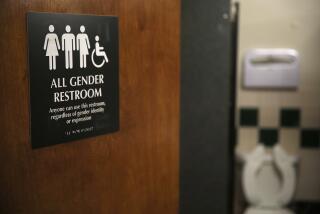International Gender Gap Is Wide Open
- Share via
NEW YORK — If given economic value, the unpaid labor of women in the household would add about one-third, or $4 trillion, to the annual gross economic product of the world.
In one-quarter to one-third of the households around the world, women are the sole breadwinners.
Educated women outscore educated men in verbal skills, but with the exception of China, there are more than 130 million more adult women than men in the world who cannot read and write.
More Boys in School
In 1950, there were 27 million more boys than girls enrolled in primary and secondary levels of education around the world. Currently there are 80 million more boys than girls enrolled.
And although women compose 50% of the world’s enfranchised population, they hold less than 8% of the seats in national legislatures.
These are among the facts and figures contained in a report on the world status of women commissioned jointly by the Carnegie Corp., and the Ford and Rockefeller foundations and issued jointly here last week.
“This is an excellent data book,” said Arvonne Fraser of the Hubert Humphrey Institute at the University of Minnesota, “illustrating the international gender gap in education, employment, health and the law.
“Historically, women have been looked at as reproducers,” Fraser said at an information session to introduce the report. “This report shows we are also the producers.”
The document, “Women: A World Survey,” was prepared by Washington social researcher Ruth Leger Sivard, author of another well-known report, “World Military and Social Expenditures.” The product of more than a year’s research, Sivard’s “broad-brushed general overview” of the condition of women internationally, as she termed the new publication, will be distributed to the 8,000 delegates and observers expected to attend the United Nations Decade for Women Conference in Nairobi this July, as well as through key organizations in the United States and Canada.
Writes Sivard, summarizing the 44-page report: “The changes achieved in women’s status during the period since World War II have been extremely uneven and, on the whole, modest. Whether in the economy, education, health or government, there is no major field of activity and no country in which women have attained equality with men.”
As she notes: “The influx of women into the paid labor force has not significantly narrowed the gap between men’s and women’s pay; nor has it stemmed the rising tide of poverty among women. Despite the key role that women have in Third World economies, they have been largely bypassed in developmental strategies.”
Significant Progress
Only in the area of higher education have women made significant progress compared to men in the last 40 years, Sivard asserts. And she concludes, “Women around the world have one thing in common--inequality with men.”
For example, Sivard points out that 10 of the 11 oldest democracies in the world waited until the 20th Century to give women the right to vote. And “in one government in three, there are no women in the executive council which represents the highest decision-making body of the country. In those countries where women are included, there is usually only one woman.”
Among Third World women, Sivard said, malnutrition is the major health problem. For these Third World women, “nutritional anemia afflicts close to half of all women in the childbearing years, and 60% of pregnant women.” In one-third of these countries, Sivard found, “maternal causes come first or second in overall death rates.”
“What we have here,” Fraser said, commenting on the Sivard report, “is the international feminization of poverty.”
“You read this,” Mayra Buvinic of the International Center for Research on Women agreed, “and you say, ‘My God, we really have not advanced at all.’ The gains we have made are so small.”
Impressive and Depressing
One reason the data contained in “Women: A World Survey” seems so stunning, Buvinic said, is that until now, “the basic problem is that the statistics that are used by governments and decision-makers grossly underestimate the economic and social participation of women throughout the world.” As such, Buvinic said, Sivard’s findings are at once “very impressive and very depressing.”
Indeed, Sivard herself noted in a telephone interview that “I think I went into this project with more optimism than I ended up with.” After completing the report, she said, “my feeling is that there’s quite a strong contrast between the surface appearance of things and the reality for women.
“I think American women,” Sivard continued, “I think here we have probably made more progress than the average worldwide, and we therefore think the whole world is moving that way.”
In short, Sivard said, “women may have come a long way, but they haven’t gone very far.”
Still, Sivard sees some cause for hope. “I think you’ve got to look at the advances,” she said. “I tried to show that, in so many ways, women are making breakthroughs, and I guess we just have to accept the fact that in the course of civilization, 2,500 years or whatever it is, women have been in an unusually marked secondary place. So it just doesn’t happen in 40 years.
“It’s going to maybe take more time,” Sivard said, “and perhaps we can’t be as impatient as we think the situation warrants.”
In a way, Buvinic said, “another ray of hope is this document. I see this document as having the potential to influence policy makers worldwide--most of whom happen to be men.
A Matter of Ignorance
“I don’t think men are intentionally doing this to us,” Buvinic said. “I think there is a lot of ignorance. But once people are knowledgeable about the facts, then they can start to do something about it.
“Hopefully this book, and (the upcoming conference in) Nairobi will bring a bit of enlightenment--and I think that is what we need.”
Besides, Fraser quipped, the Sivard report is filled with charts and statistics, and hence “because men love statistics” will probably be well read by male policy makers.
But, as the Carnegie Foundation’s Jill Sheffield said, “one of the hopes that we have for this book is that it will help demystify some of the statistics.” Then, holding up the document’s bright red cover, Sheffield added, “This report is the color of dynamite, and what’s inside is dynamite as well.”
Fraser, for one, dismissed the notion that the findings in this report might actually prove divisive at the Nairobi conference, whose predecessor gatherings often have been marred by sharp political differences among the participants.
“Of course we are divided on political issues,” Fraser said. “We are patriots, we are citizens, but we are also women. And like scientists, we transcend our political differences.”
More to Read
Sign up for Essential California
The most important California stories and recommendations in your inbox every morning.
You may occasionally receive promotional content from the Los Angeles Times.










